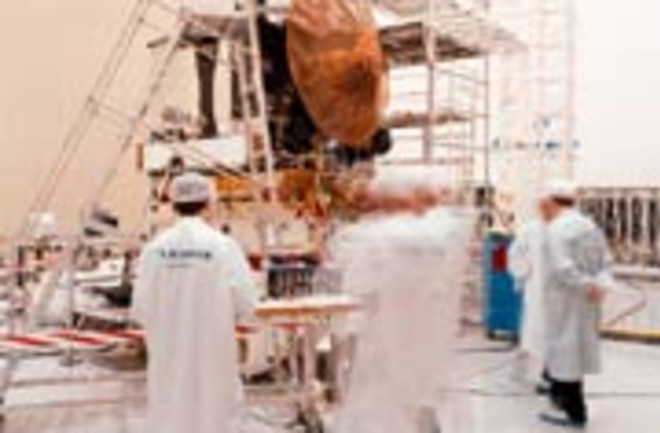One morning last September in Toulouse, France, Antonio Rodotà, director general of the European Space Agency, stood in front of a crowd of reporters who had flown in from all over Europe to gather in a cavernous hangar. The floor of the hangar was covered with a red carpet, and the pretty young hostesses who handed out the press kits were wearing bright red dresses. Moments earlier, to a sound track of sopranos floating over driving electronic rhythms, a large door on the reporters' left slid open, unveiling a full-scale mock-up of Mars Express — the spacecraft ESA plans to launch in late May or early June.
The model was suspended from the roof of the darkened hangar and bathed in nocturnal blue light. As the music swelled, spotlights caressed the model's extended solar panels and its large, steel gray radio dish. They then turned to illuminate two bright red Ferraris. One was a Formula 1 race car. A photo of Mars floated like a rust red moon on the far wall of the hangar. ESA was calling this event the Red Encounter.
Rodotà, a genial, gray-bearded, distinguished-looking Italian, stood onstage with other European space dignitaries, looking a bit ill at ease. He and everyone else in the hangar were wearing floppy disposable overshoes; later they would put on hairnets and lab coats and shuffle into a nearby clean room. There they would watch and snap pictures as Rodotà and ESA's science director, David Southwood, supervised the attachment of a vial of Ferrari-red paint to the underside of the real Mars Express. Thus, if all goes well, the paint, too, will enter Martian orbit next December. Rodotà had the unenviable task of explaining all this.
"Why are we here today?" he began. "Why this strange joining of cars and satellites?" Ferrari, he acknowledged, did not need the publicity; it was ESA that was basking in Ferrari's red glow, trying to link its own feats of engineering in the public mind with sexy race cars. Not only are Europeans far more familiar with Ferrari than with ESA, Rodotà pointed out, they are also more familiar with NASA: A 1998 poll showed that 54 percent of them knew about the American space agency, but only 10 percent had heard of their own. The ratio of those two numbers, he added sardonically, is about the same as the ratio of the two space agencies' budgets — NASA's is five times larger, even though the collective gross domestic product of ESA's 15 member states is close to that of the United States. That poll had made Rodotà realize that his agency must work quite a bit harder at public relations.
NASA, in the aftermath of the shuttle tragedy, has all the public attention it needs. But ESA deserves far more than it gets. With a science budget of around $350 million a year, less than the cost of a single space shuttle launch, Southwood runs an ambitious program. Last October ESA launched a gamma-ray telescope called Integral as a companion to its successful X-ray telescope XMM-Newton, already in orbit. Over the next decade, the agency plans to launch infrared and microwave telescopes as well. ESA also intends to send spacecraft to Venus and Mercury, which are not even on NASA's schedule. Even more amazing, it plans to land a probe on a comet.

